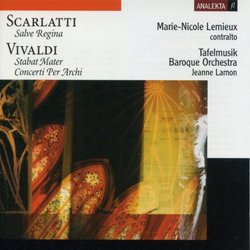| All Artists: Antonio Vivaldi, Domenico Scarlatti, Charles Avison, Tafelmusik Baroque Orchestra Title: Scarlatti: Salve Regina; Vivaldi: Stabat Mater; Concerti Per Archi Members Wishing: 1 Total Copies: 0 Label: Analekta Original Release Date: 1/1/2003 Re-Release Date: 4/3/2007 Genres: Pop, Classical Styles: Vocal Pop, Opera & Classical Vocal, Chamber Music, Forms & Genres, Concertos, Historical Periods, Baroque (c.1600-1750), Classical (c.1770-1830), Sacred & Religious, Symphonies Number of Discs: 1 SwapaCD Credits: 1 UPC: 774204317126 |
Search - Antonio Vivaldi, Domenico Scarlatti, Charles Avison :: Scarlatti: Salve Regina; Vivaldi: Stabat Mater; Concerti Per Archi
 | Antonio Vivaldi, Domenico Scarlatti, Charles Avison Scarlatti: Salve Regina; Vivaldi: Stabat Mater; Concerti Per Archi Genres: Pop, Classical
|
Larger Image |
CD Details |
CD ReviewsAn Emerging Contralto Phenomenon: Marie-Nicole Lemieux J Scott Morrison | Middlebury VT, USA | 11/12/2003 (5 out of 5 stars) "This is a nicely put together program of high Baroque music with music by Avison, Vivaldi and Domenico Scarlatti. It features that wonderful Canadian baroque orchestra, Tafelmusik, conducted by their music director, Jeanne Lamon. But, best of all, it has two extended pieces for contralto and orchestra that give prominence to a new, to me, and evidently rather young contralto, Marie-Nicole Lemieux, who has me thinking of that other Canadian contralto, Maureen Forrester, who also sang baroque music exquisitely in her day. First is a brief Sinfonia in G for Strings (RV. 149) by Vivaldi acting as an overture leading us into the seven-movement 'Salva Regina' of Domenico Scarlatti. We don't ordinarily think of Domenico in connection with vocal music; it's usually his father, Alessandro, whose music we hear. But the younger man certainly could write for the voice. Lemieux has a noble sound and plenty of flexibility for this simple, yet baroquely florid, music, and she sings the imploring text, appropriate for Pentecost, with feeling. 'Ad te clamamus' ('To thee we cry') with the following 'Ad te suspiramus' ('To thee we offer our sighs') are moving.The orchestra follows with Charles Avison's Concerto in G Minor, a string orchestra setting he made of four of Domenico Scarlatti's 'Essercizi per Gravicembalo' (or, as we usually call them in English, 'Sonatas,' that group of 555 masterpieces so beloved by us keyboard players). Avison's arrangement and this performance convey the sonatas' 'ingenious jesting with art,' the phrase Scarlatti used to describe them. There is some luscious solo violin playing here, almost certainly that of Mme Lamon herself.Next is Vivaldi's well-known nine-movement 'Stabat Mater' for contralto, strings and continuo. (This is as good a place as any to praise the solid continuo harpsichord/organ playing of Olivier Fortin; in this piece he provides the subtle but immensely important organ underpinning.) An early work, it shows Vivaldi's already notable skill at mood-setting. The first section of the poem, depicting the Virgin weeping at the foot of the Cross as her Son is crucified, with its sobbing strings and imploring vocal line, is utterly effective, especially with Mlle Lemieux's artful singing. Similarly effective is the 'Quis est homo qui non fleret' ('What man would not weep') section. [A recent recording with countertenor David Daniels cannot compete with this. I do, however, remember a performance with Janet Baker that may have been superior to this--not recorded by her as far as I know--that reduced me to tears.] The final 'Fac, ut ardeat' ('Make my heart burn') and 'Amen' are a worthy conclusion to this ardent performance. A triumph for all concerned.The program, constructed much like an actual concert might have been, concludes with Vivaldi's Concerto for Strings in A Major, RV. 158, which lightens the mood set by the tragic 'Stabat Mater.' The precision, ensemble and spirit of the Tafelmusik strings is worthy of praise.A hearty recommendation.TT= 57:37Scott Morrison"
|

 Track Listings (26) - Disc #1
Track Listings (26) - Disc #1